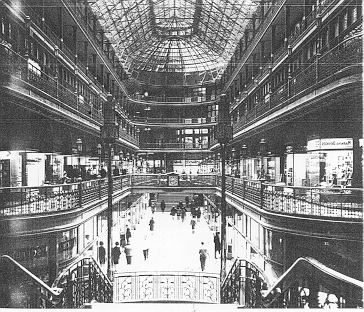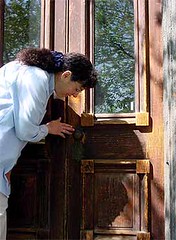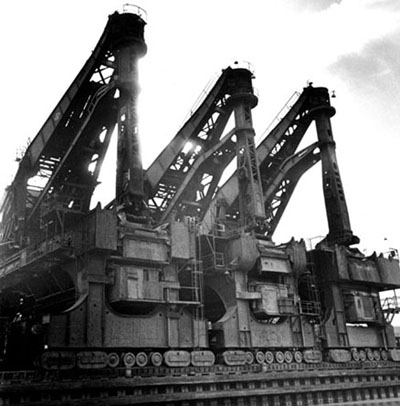Preserving historic places of yesterday makes them useful for today
 Cleveland Arcade (Ohio).
Cleveland Arcade (Ohio).A statement by Patricia S. Eldredge, newly installed president of the Ohio Historical Society:
(Note: in Ohio, the OHS is the "contractor" that runs the Ohio State Historic Preservation Office. One of the best conference presentations I've seen was about the Ohio "Building Doctor" program, which is one of the best general presentations around about the value of historic preservation, what it means, and what it means practically in terms of buildings and their maintenance and preservation.)
(Reprinted from the Times Reporter of Dover-New Philadelphia, Ohio.)
When people think about historic preservation, they usually think about old buildings. It's hard to blame them. We're accustomed to thinking this way, mostly because of the language we use. When I think of historic preservation, wearing my new hat as president of the Ohio Historical Society, I think of people and community. Let me explain why.
Preserving venerable old buildings and making them useful for today is certainly an important part of historic preservation. But it is about so much more. It is about the power of place, the significance of community and the stories of people. Ohio has more than 200 years of statehood under its belt, but people have inhabited this land for thousands of years. Our state has tens of thousands of historic places with architecturally significant buildings, archaeological sites, roadways, canals, gardens, streetscapes, parks, church yards, scenic trails, cemeteries, battle sites, memorials and other public spaces with historic significance.
Simply put, these places are worth preserving because they are important to people and they tell us about who we are and from where we come. Ohio's story is really the American story - westward expansion, the Underground Railroad, industrialization and even space travel.
 A Building Doctor on Call. Photo: Ohio Historical Society.
A Building Doctor on Call. Photo: Ohio Historical Society.Old buildings do play a large part in this history because of the role they play in enhancing our own quality of life. Wherever you are in Ohio today, you can see parts of our heritage being renewed and rejuvenated for 21st-century use. This kind of re-development not only preserves our history, it also contributes to Ohio's economy in a big way.
In 2003 alone, more than 5,000 local jobs were created based on $237 million in historic rehabilitation tax credit projects in Ohio. In addition, those neighborhoods where historic preservation is at work are often those unique spaces which attract creative people and bring in tourist dollars. Perhaps most importantly, they are the kinds of places where people like to be and to live.
Historic preservation is hard work. The Society's Ohio Historic Preservation Office consults with agencies, architects, archaeologists, planners, developers, local governments, organizations and individuals throughout Ohio to review thousands of projects each year, list properties on the National Register of Historic Places, and provide technical assistance.
I invite you to join me and the rest of the Ohio Historical Society in preserving Ohio's past and embracing our future. Like me, I am sure you will discover historic preservation is about so much more than saving old buildings.
________
This NPS article describes the Building Doctor program.
 The Hulett Automatic Ore Unloader was invented by George H. Hulett, a native of Ohio, in the late 1800's. He recieved the patent for this invention in 1898 and the following year the first working model was built at Conneaut Harbor in Conneaut, Ohio. It was constructed by the Webster, Camp & Lane Company of Akron. The Hulett Automatic Ore Unloader became an essential element in the development of the iron ore industry in Ohio, allowing rapid unloading of cargos and increasing the volume and efficiency of ore docks at Ohio ports such as Ashtabula, Cleveland, Conneaut, Huron, Lorain, and Toledo. The machines remained in use, with few changes, until 1992. Though most have now been disassembled, six still stand as reminders of their domination of iron ore unloading. Four of these six are located on Whiskey Island at Cleveland, Ohio. Their fate is uncertain, as there is now a debate over whether or not they should be dismantled to make way for new waterfront development in Cleveland or preserved as a reminder of Cleveland's industrial heritage. (Source: Great Lakes Industrial History Center.)
The Hulett Automatic Ore Unloader was invented by George H. Hulett, a native of Ohio, in the late 1800's. He recieved the patent for this invention in 1898 and the following year the first working model was built at Conneaut Harbor in Conneaut, Ohio. It was constructed by the Webster, Camp & Lane Company of Akron. The Hulett Automatic Ore Unloader became an essential element in the development of the iron ore industry in Ohio, allowing rapid unloading of cargos and increasing the volume and efficiency of ore docks at Ohio ports such as Ashtabula, Cleveland, Conneaut, Huron, Lorain, and Toledo. The machines remained in use, with few changes, until 1992. Though most have now been disassembled, six still stand as reminders of their domination of iron ore unloading. Four of these six are located on Whiskey Island at Cleveland, Ohio. Their fate is uncertain, as there is now a debate over whether or not they should be dismantled to make way for new waterfront development in Cleveland or preserved as a reminder of Cleveland's industrial heritage. (Source: Great Lakes Industrial History Center.)Index Keywords: historic-preservation



0 Comments:
Post a Comment
<< Home